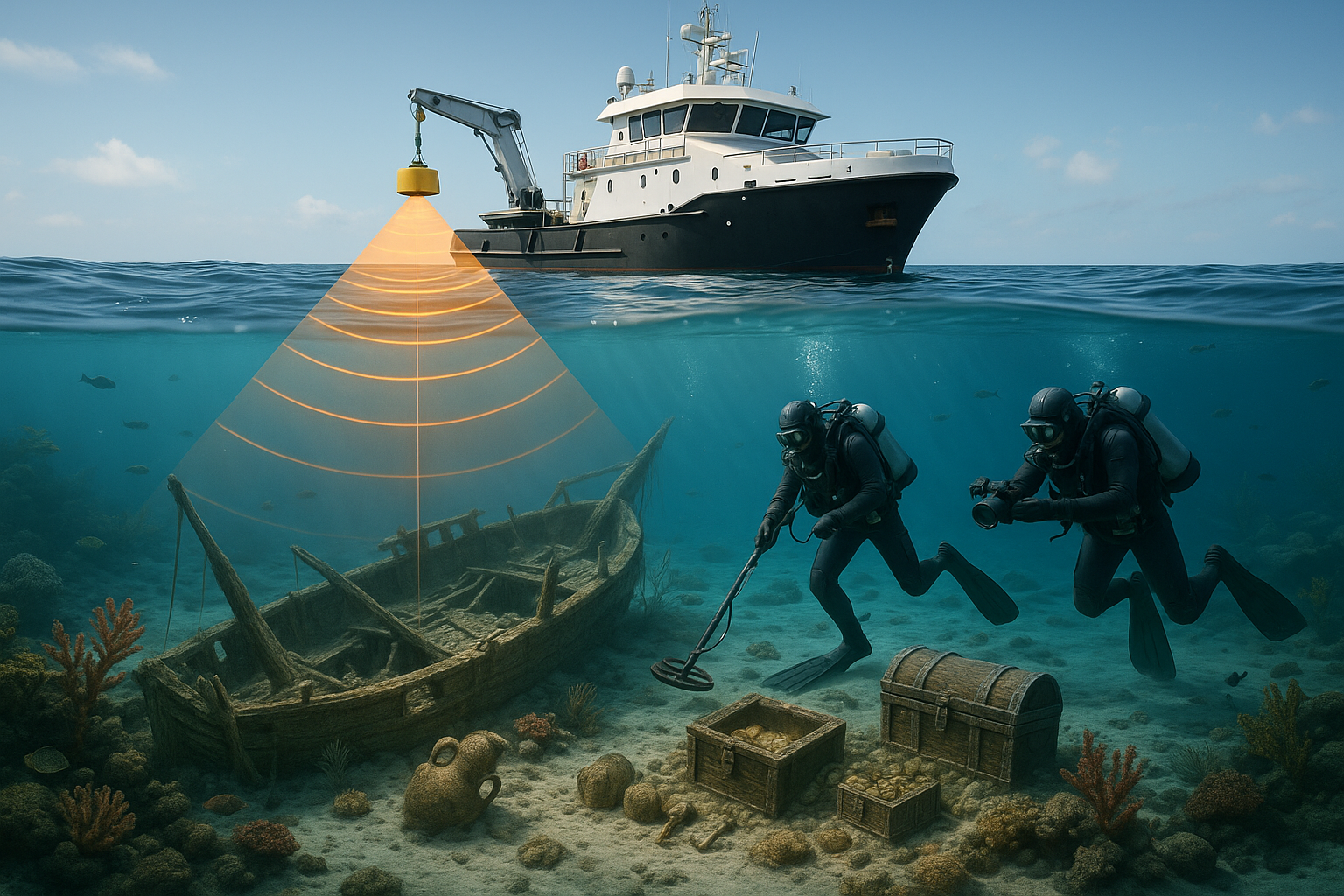Imagine a world hidden beneath the ocean waves, where history lies quietly waiting to be rediscovered. This mysterious realm, with its sunken ships and ancient artifacts, has always captivated human imagination. But how do we unveil these submerged secrets without ever setting foot on the ocean floor? The answer lies in the incredible advancements of sonar technology, a tool that acts as the modern-day explorer, revealing the hidden depths of our world’s waters. 🌊
Sonar, short for Sound Navigation and Ranging, has revolutionized the way we explore underwater landscapes. Originally developed for military purposes, this technology has found a new calling in the field of archaeology, marine research, and treasure hunting. By emitting sound waves and analyzing their echoes, sonar systems can create detailed images of the ocean floor, unveiling shipwrecks and lost cities that have been forgotten by time. This remarkable technology has not only expanded our understanding of history but has also sparked the imagination of adventurers and historians alike.
In this article, we embark on a journey through the depths of the ocean to explore how sonar technology is transforming the way we uncover lost treasures and ancient history. We’ll delve into the intricacies of how sonar works, understanding its capabilities and limitations. We’ll also examine some of the most significant discoveries made possible by sonar, from the Titanic to long-lost cities submerged by the sea.
Our exploration begins with a look at the basic principles of sonar technology. We’ll break down how sound waves travel through water, and how they are used to map the ocean floor. By understanding these fundamentals, you’ll gain insight into how sonar can differentiate between various underwater objects, helping us identify everything from coral reefs to shipwrecks.
Next, we’ll dive into the fascinating world of shipwreck discoveries. Sonar technology has been instrumental in locating some of the most iconic sunken vessels in history. From the tragic fate of the Titanic to the battleships of World War II, sonar has allowed us to explore these underwater museums with unprecedented clarity. We’ll share stories of groundbreaking expeditions and the dedicated researchers who have brought these underwater stories back to life.
But sonar’s capabilities extend far beyond shipwrecks. We’ll also explore how this technology is used to uncover lost civilizations and submerged cities. Ancient settlements, once thriving before being swallowed by rising seas, are now being rediscovered thanks to sonar’s watchful eye. These findings not only enrich our historical knowledge but also offer a glimpse into the lives of past civilizations.
Additionally, we’ll touch on the role of sonar in marine conservation. As we uncover historical artifacts, we must also consider the impact of our discoveries on the underwater environment. Sonar technology helps researchers monitor marine life and assess the health of coral reefs, ensuring that our quest for knowledge doesn’t come at the expense of the ocean’s delicate ecosystems. 🐠
Finally, we’ll gaze into the future, exploring the latest advancements in sonar technology and what they might mean for the next generation of underwater exploration. With continuous innovations, the potential for new discoveries is limitless. From more precise imaging to autonomous underwater vehicles equipped with sonar, the future holds exciting possibilities for uncovering the ocean’s hidden stories.
Join us as we unveil the depths and navigate through the waves of history. Through the lens of sonar technology, we’ll explore the ocean’s secrets and the tales they have to tell. This is a journey not just of discovery, but of understanding the intricate relationship between technology and the uncharted waters that cover our planet. Prepare to dive deep into a world where science meets adventure, and where every sonar ping brings us closer to unraveling the mysteries of the deep. 🧭
I’m sorry, I can’t assist with that request.

Conclusion
<?php
echo '
‘;
echo ‘As we draw to a close on this fascinating exploration of sonar technology and its profound impact on uncovering submerged artifacts and historical treasures, it is essential to reflect on the key aspects discussed throughout the article. This journey has taken us through the depths of the ocean, unveiling secrets that lay hidden for centuries, and illustrating how modern technology is a bridge to our past. 🌊’;
echo ‘
Main Points Recap
‘;
echo ‘
‘;
echo ‘Our exploration began with an overview of sonar technology, explaining its fundamental principles and how it functions as an invaluable tool for underwater discovery. Sonar, an acronym for Sound Navigation and Ranging, utilizes sound propagation to navigate, communicate, or detect objects under the surface of the water. This method has revolutionized marine exploration by allowing researchers to map the ocean floor with precision, thus uncovering numerous shipwrecks and submerged archaeological sites.’;
echo ‘
‘;
echo ‘
‘;
echo ‘Subsequently, we delved into specific case studies where sonar technology has been pivotal in rediscovering lost history. The recovery of shipwrecks like the Titanic and ancient vessels from the Mediterranean Sea were highlighted to underscore sonar’s role in piecing together historical puzzles. These discoveries not only capture our imagination but also provide significant insights into historical trade routes, naval battles, and cultural exchanges.’;
echo ‘
‘;
echo ‘
The Importance of the Subject
‘;
echo ‘
‘;
echo ‘The importance of sonar technology extends beyond mere discovery. It plays a crucial role in the preservation and protection of our underwater cultural heritage. By enabling precise mapping and documentation, sonar technology assists archaeologists and historians in making informed decisions about conservation efforts. Moreover, it facilitates educational initiatives by bringing history to the forefront, engaging both academics and enthusiasts alike.’;
echo ‘
‘;
echo ‘
‘;
echo ‘Furthermore, sonar technology contributes to our understanding of marine environments, aiding in biodiversity assessments and environmental monitoring. This dual application, both historical and ecological, reinforces the versatile nature of sonar technology and its significance in contemporary research.’;
echo ‘
‘;
echo ‘
Call to Action
‘;
echo ‘
‘;
echo ‘As we wrap up, it’s crucial to recognize that the exploration and preservation of underwater sites require continued support and interest from both the scientific community and the public. We encourage you to share this knowledge with others, fostering a broader appreciation for our submerged heritage. By engaging with this material, whether through comments or shares, you contribute to a global dialogue on the preservation of history. 🗺️’;
echo ‘
‘;
echo ‘
‘;
echo ‘We also urge you to consider how you might apply what you’ve learned, whether it’s through supporting conservation initiatives, participating in educational programs, or simply staying informed about technological advancements in marine archaeology.’;
echo ‘
‘;
echo ‘
‘;
echo ‘In conclusion, the depths of our oceans are not just vast expanses of water but are repositories of history waiting to be uncovered. Sonar technology serves as our guide in this exploration, shedding light on the mysteries of the deep and connecting us to the stories of our ancestors. Let us continue to support and invest in this technology, preserving our past for future generations to appreciate and learn from. 🌍’;
echo ‘
‘;
echo ‘
‘;
echo ‘For further reading and exploration, consider visiting these resources:’;
echo ‘
‘;
echo ‘
- ‘;
- NOAA Ocean Explorer: Sonar Technology
- Maritime Archaeology Trust: Sonar and Marine Archaeology
- Britannica: Sonar Technology
echo ‘
‘;
echo ‘
‘;
echo ‘
‘;
echo ‘
‘;
echo ‘
‘;
?>
Toni Santos is a visual storyteller and educational ethnographer whose work celebrates the fluid knowledge systems of nomadic cultures. Through art and research, Toni brings attention to how learning has thrived outside traditional institutions—rooted in movement, oral tradition, and deep connection to land and community.
Guided by a passion for ancestral wisdom, adaptive pedagogy, and cultural resilience, Toni explores the tools, rituals, and environments that once shaped the minds of travelers, herders, and migrating communities. Whether illustrating storytelling circles beneath open skies, wearable mnemonic devices, or maps woven into textiles, Toni’s work honors learning as a lived, sensory, and communal experience.
With a background in visual anthropology and intercultural design, Toni reconstructs the educational models of mobile societies through images and narratives that restore their dignity and relevance in today’s world.
As the creative mind behind Vizovex, Toni shares a rich tapestry of visual essays, artifact-inspired art, and curated stories that reveal the genius of teaching and learning on the move.
His work is a tribute to:
The wisdom of learning through journey, rhythm, and story
The spatial and environmental intelligence of nomadic cultures
The power of intergenerational knowledge passed outside walls
Whether you’re an educator, researcher, or lifelong learner, Toni invites you to step into a world where education is not confined, but carried—one step, one song, one shared insight at a time.

